28 Oct

The growth of every business is to compare the results of one campaign against another, especially in email marketing. This is carried out to determine which one works best, and A/B Testing in Klaviyo makes this possible.
This invariably implies that the open and click-through rates of your emails can be increased using the insights gotten from the testing. As such ideas are built to run your future email campaigns for better results.
Table of Contents
A/B Testing in Email Marketing
A/B Testing is the process of creating two variations of a campaign, sending one variation to a subset of your target audience/subscribers and the other variation to another subset of your email subscribers. This is done with the sole goal to determine which variation of the campaign obtained the best result.
The A/B testing varies from simple to complex depending on the particular thing you would love to test. It is done to determine the campaign that would generate more open or click-through rate or the most conversions. So, with the information obtained, the best-performing variation of your campaign is sent to the rest of your audiences.
A/B testing in email marketing is reliant on the various elements of a campaign as compared in its two different variations. These campaign elements contained in the variations may include the following:
- Subject Lines – To check on the word ordering or arrangements, word length, content, and personalization.
- Visuals – can check on the use of images or not with styles which work best.
- Copy – consider great writing based on length, personalization, and tone.
- Calls to Action – weighs in on the button or text-links which is preferable. Etc.
A/B Testing requires consistency to always deliver improved results on campaigns as expected if carried out by creating hypotheses of email elements, prioritization based on audience, and learning to build with the right marketing tool like Klaviyo.

Importance of A/B Testing
The ultimate objective of this testing is to improve on the marketing success of any business by measuring what is working based on the key email metrics: unsubscribers, open rate, click-through rate and conversion rates.
These metrics provide you with counts or insights to the results of how many people opened the email, the clicks on the call-to-action and unsubscriptions that occurred in the campaign you sent.
Klaviyo is one of the best email marketing platforms for business selling something online. If you knew the process of performing a successful A/B Test in Klaviyo, you can explore more proficient marketing with the platform.
Performing A/B Testing in Klaviyo
Before you start your A/B testing process, write down the following attributes on paper. Many people carry out A/B Testing without having a good understanding of these six attributes, the end result would always be a very poor measurement of your statistics and poor learning, or even inaccurate results. But, having these 6 attributes sorted out, would help you to keep your activities organized in order to have a perfect comprehension of your results and create a concrete action plan on what to do next.
The 6 attribute you must have before starting your A/B Test are:
- Know your status
- What is the test idea?
- Develop a hypothesis
- Outline some success metrics
- What is your projected result?
- Create a follow up plan based on your actual results.
The Process of A/B Testing a Campaign in Klaviyo
Login in to your Klaviyo Account > click the Campaign Tab > Create Campaign.

Enter the campaign name and select the tags you want to use (you can create one or equally combine tags). Then click on the Create Campaign button.

A page appears where you need to select who you are sending the campaign to (i.e. choose a list or segment), either to use Smart Sending or not and use UTM Tracking or not. Then click Save & Continue to Content.
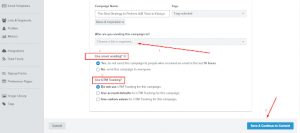
Fill in the following columns: Enter your brand name or any sender name you want to use in the From, email in From/Reply-To Email, Subject, and Preview Text, after that, click on Save Changes.
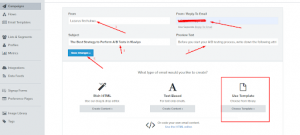
Select the type of Create Content you would like to use: whether Rich HTML, Text-Based, Use Template or Use the HTML editor to create your email content.
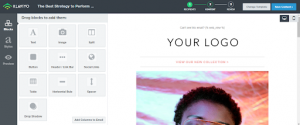
On choosing any of the above, you can create content using Blocks like the Text, Image, Split, Button, Header/Link Bar, Social Links, Table, Horizontal Rule, Add Columns etc. Equally check on the Styles to adjust Email, Text, Links, Headings, Mobile, Desktop, Date Format, and Background, etc. and as well see Previews before you Save Content.
Here comes the main thing: click on Add variation link to enter directly to the A/B testing page. On the Manage Variation heading, you can now add more variations or edit to differ with each other for your test analysis.
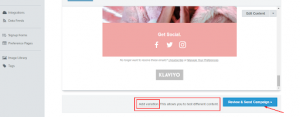
With Test Settings, limit your sample audience to a percentage (0-100% with the slider) you would like to receive the test mail. Specify the time duration (6-92 hours) to determine the winning variation, campaign winning criteria (Open Rate, Unique Click), and check/uncheck to add variation letter as UTM parameter to all links. Also, click Switch to Test Send Times link if you want to change the variation send timings and dates.
Click on Save & Schedule Campaign, you are prompted to make a final review if any, then click the Schedule (time, date and time zone) to choose a time & date for delivery or preferably Send Now tab. Also, check the Determine Recipients at Send Time box if you like and finally click on the Schedule button.
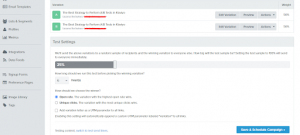
Note: Any variation that wins based on the test objective specified, the email variation is automatically sent to the remaining percentage of your lists or target audience.
After the set time-frame has elapsed, you can now review your A/B Testing to properly analyze the result.
Navigate to the test campaign, Select the Variation >> Overview >> Recipient Activity or Link Activity to view the analytics concerning any of the conversion metrics.
Note: Test one variable at a time. Don’t use more than 4 variations. Don’t edit a live test. This would go a long way to ensure success in your business using email marketing.
There is a lot more to do with the performance metrics obtained from the variations in a campaign. This whole data can be used to strategize for your next campaigns, or you can also use the data to carry out a second level of test where you compare the winning elements to a different set of variables in order to arrive at a more firm results, which you can use to plan your communication campaigns with your audience.
Furthermore, whether or not you intend on carrying out a second or third level of A/B testing on your campaigns, it is always more rewarding to continue testing different variables across your campaigns, this is the only way you can continue to stay afloat and keep to tactics that currently work instead of sticking to old ways and risk being left behind. Things change and your audience attitude also changes sometimes, A/B Testing is the best way to know what is working now.
This is one of the reasons it is important to engage an email marketing expert who will carefully create your email marketing campaigns and analyze reports if you are not conversant with the above technical breakdown on how to go about A/B Testing in Klaviyo. Even if you are able to follow the step by step process, the real expertise is actually gathering the most relevant data from the test campaigns and results and deploying this data to further create more successful campaigns in the future.
The marketing expert should be able to develop a hypothesis of the campaign like the subject lines, CTAs, contents/copy and various layouts etc. run your campaigns and give feedback to the process of the marketing.




